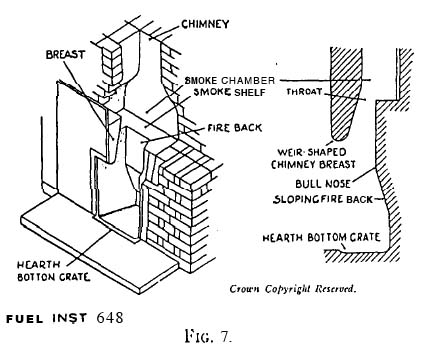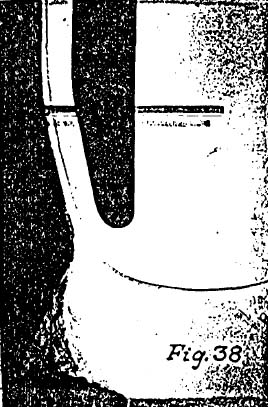Rosin Fireplaces
Rosin, P.O.
"The Aerodynamics of Domestic Open Fireplaces"
Journal of the Institute of Fuel, Vol 12, 1939, pp. 198-224.
Advance copy of paper presented to the Institute of Fuel
3 MB. Off line.
 Fig. 7 shows a diagram. This construction is founded upon the prcscriptions given by Rumford (2) He introrluccd the wedge-shaped fireplace opening towards the room, the forward sloping firebrick back with smoke shelf and the smoothly curved weir-shaped chimney-breast. After more than a century of application his prescriptions were successfully revived and revised by Dr. A.F. Dufton, of the Building Rescearch Station. 1 am indebted to the Departmcnt of Scientific and Industrial Rcscarch and to the Controller of H.M. Stationery Office for permission to reproduce this dingram.
Fig. 38 finally shows a streamline chimney without a
canopy, shelf or smoke chamber, in which no edddies are
present. But this can only be accomplished, if the
chimney is not much wider than the throat, and the lateral
contraction very gradually effected. The three fundamental
requircmcnts are therefore
|
The Rosin fireplace is a modification of a Rumford by P.O. Rosin who developed the modification in the late 1930's. Rosins are good fireplaces but I'm not convinced they are better than Rumfords. Rosin, himself, was very modest in his proposal which was based on scale modeling and so subject to errors of scale. He also didn't use heat. His models involved dropping salts in a fluid through a small inverted scale model fireplace and observing the "streamlines" by taking time exposure photographs of the salts falling through the fluid. Trying to maximize radiation, Rosin suggested a parabolic shaped "modern" firebox shape rather than one made of firebrick and to minimize turbulence he recommended streamlining the exit to the throat as well as the entrance as Rumford did. I think Rosin's paper is interesting and useful but Rosin (or Dufton) gets Rumford wrong which is not confidence producing. And why is it important to eliminate turbulence above throat? Will it reduce the flue size needed? If so, no one has shown that to be so. Rumford said the termination of the throat should be perfectly flat to discourage downdrafts: ... the top of the throat of the chimney, where it ends abruptly in the open canal of the chimney, by a horizontal course of bricks well secured with mortar. ... It is of much importance that they should end in this manner; for were they to be sloped outward and raised in such a manner as to swell out the upper extremity of the throat of the chimney in the form of a trumpet, and increase it by degrees to the size of the canal of the chimney, this manner of uniting the lower extremity of the canal of the chimney with the throat would tend to assist the winds which may attempt to blow down the chimney, in forcing their way through the throat, and throwing the smoke backward into the room; but when the throat of the chimney ends abruptly, and the ends of the new walls form a flat horizontal surface, it will be much more difficult for any wind from above to find and force its way through the narrow passage of the throat of the chimney. Chapter II, Rumford's 1796 Essay. So, is the Rosin an improvement? I don't know since none of the Rosins - Belfires in New York or Frisch Rosin in Washington or what they call a Milner in England - have been built as Rosin suggested and, in any configuration, have not been tested (or if they have the results have not been made public) for emissions or efficiency as an open fireplace. Belfires has an "optional" stainless steel Rumford throat modeled after our Rumford throat but not the hour glass shaped throat Rosin advocated. The claims for improved aerodynamics or cleaner-burning are all sales propaganda in the absence of third party test data. Bottom line, Rumfords, with a firebrick firebox, are more traditional looking and can be built any size you like, such as 36"x36". Rosins are all about 24" tall and can be made wider with "wings" but not taller.
|

Comments
Buckley Rumford Fireplaces
Copyright 1996 - 2012 Jim Buckley
All rights reserved.
webmaster
